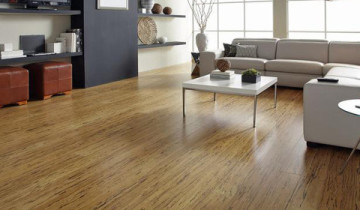Sustainable Floors – Gorgeous Floors that are “Green”
We humans are the stewards that look out for the health of our planet. Choosing eco-friendly flooring is one way towards ensuring a healthy environment for our kids and future generations.
Five Reasons to Choose Eco-Friendly (Green) Flooring
- Many eco-friendly floor choices use recycled materials and leads to reduced dependence on oil
- Green flooring products often last longer than regular flooring materials
- Eco-friendly floors makes your home safer for you, your family, and the environs.
- Products that are green are usually recyclable and do not fill our landfills needlessly
- Green flooring looks great, creates pride of ownership and makes you feel good about your choice
To be considered a green flooring product, the flooring material must meet at least one of the following criteria:
- Recyclable
- Sustainable
- Has a small carbon footprint
- Has recycled content
- Has low volatile organic compounds (VOCs)
Recyclable Flooring
We reuse flooring in whole, or partly, to make new flooring or other products. Examples of recyclable flooring include:
- Carpet
- Bamboo
- Stone
- Cork
- Linoleum
- Hardwood
- Ceramic Tile
Sustainable Flooring
Sustainable flooring comes from harvested natural products that under management so they are not over-harvested and sources are renewable. Examples of sustainable flooring include:
- Hardwood
- Cork
- Bamboo
Flooring with a Small Carbon Footprint
We calculate a product’s carbon footprint by the consumption of resources (mostly energy) used in production. Flooring with a small carbon footprint includes:
- Wool carpeting
- Synthetic carpeting with The Green Label or Green Label Plus from the Carpet and Rug Institute
- Linoleum
- Bamboo
Stone and ceramic tile are environmentally friendly flooring products. Due to their weight, they use more energy resources than other flooring products and have a larger carbon footprint for this reason.
Recycled Content
Some environmentally friendly flooring has products that come from other products (including flooring). Examples include:
- Stone
- Linoleum
- Hardwood
- Carpet
Low Volatile Organic Compounds
According to the Minnesota Department of Health, VOC’s are:
“Volatile Organic Compounds (VOCs) are a large group of carbon-based chemicals that easily evaporate at room temperature. While most people can smell high levels of some VOCs, other VOCs have no odor. Odor does not indicate the level of risk from inhalation of this group of chemicals. There are thousands of different VOCs produced and used in our daily lives. Some common examples include:
- Acetone
- Benzene
- Ethylene glycol
- Formaldehyde
- Methylene chloride
- Perchloroethylene
- Toluene
- Xylene
- 1,3-butadiene”
When using products containing these chemicals in flooring, the chemicals release invisible gases into our home’s environment. Authorities say that indoor air has three times the contaminants as outdoor air. Flooring is a large contributor to this problem. However, most eco-friendly flooring emit little or no VOC vapors. These include:
- Wool carpet
- Hardwood
- Bamboo
- Cork
- Stone
There are adhesives used in attaching the flooring material that are non-toxic. Another consideration is to make sure that you use a non-toxic, sustainable product for the underlayment of carpeting.
There are many choices for eco-friendly flooring and we can tell about which flooring meets your needs best without harming the environment. Chicago metro-area residents and businesses interested in amazingly stylish flooring that is eco-friendly call Trevino Flooring at (847) 808-7100.
Photo Credit: Mokkie/Creative CommonsAttribution-Share Alike Courtesy: Wikimedia Commons
Sources: www.wfca.org/Pages/Green-Flooring-Materials.aspx, http://www.greenamerica.org/livinggreen/flooring.cfm, http://www.health.state.mn.us/divs/eh/indoorair/voc/

